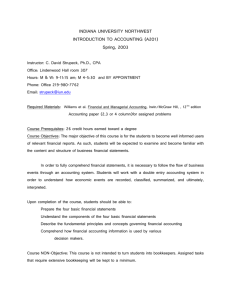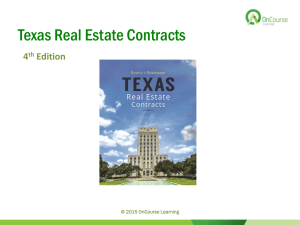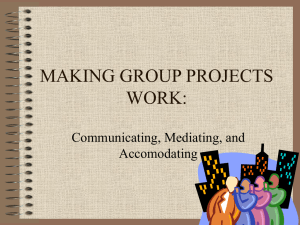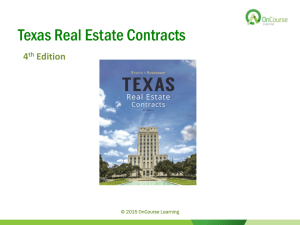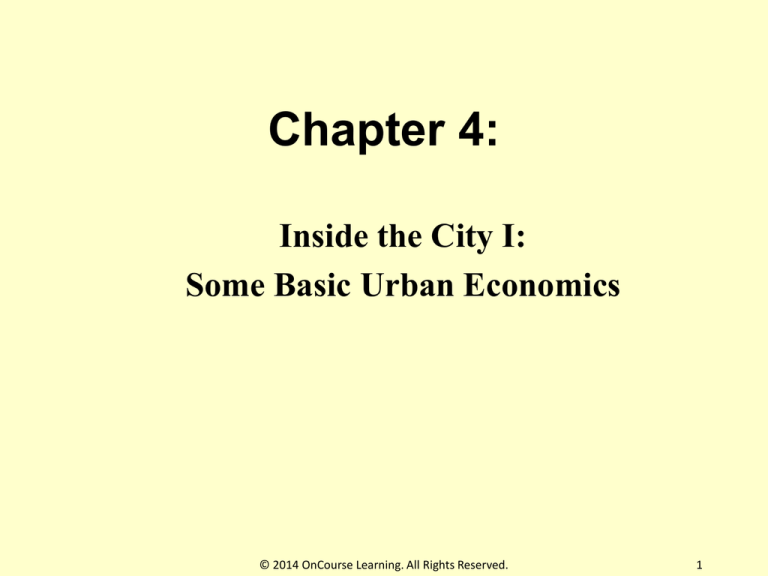
Chapter 4:
Inside the City I:
Some Basic Urban Economics
© 2014 OnCourse Learning. All Rights Reserved.
1
“Location, location, location…”
Ch.3 was about the 1st level of “location” (city
location & city size).
Ch.4 goes inside the city:
– The nature of land use spatial patterns within the
city: “urban form” (“urban spatial structure”).
– Important for:
Understanding property values in different neighborhoods
What types of buildings & land uses are feasible in a given
location, at a given time.
Location value Land value LRMC shape LR rent
trend.
© 2014 OnCourse Learning. All Rights Reserved.
2
Chapter 4
Learning Objectives
What determines land rents in a city.
Why and how a freely functioning, competitive land
market will lead to land being used at its “highest and best
use” (i.e., most productive use).
What determines how big spatially or how dense a city is.
What determines the relative land values at different
locations within a city, and the relative growth rate of these
values at different locations.
Why different land uses and densities occur at different
locations within a city.
© 2014 OnCourse Learning. All Rights Reserved.
3
4.1.1 Location & the Residual
Nature of Land Value
Value of land is based on supply (of land)
and demand (for land).
“Land” = “Space & Location.”
© 2014 OnCourse Learning. All Rights Reserved.
4
Demand for land
Demand for land is derived demand. Land has value
only because it enables production or consumption
of goods & services. Land provides space and
location for…
– Living (residential land use)
– Industrial production of goods (industrial land use)
– Storage & distribution of goods (warehouse & retail
–
–
–
–
land uses)
Administration & control (office land use)
Provision of services (office & retail land uses)
Recreation & entertainment (retail & park land uses)
Etc…
© 2014 OnCourse Learning. All Rights Reserved.
5
Residual Theory of Land
Value:
– Land value is the difference between the value
of what is produced on the site and the cost of
producing it there.
© 2014 OnCourse Learning. All Rights Reserved.
6
Consider a clothing factory:
Factory
(Machines,
Buildings):
Physical Capital
Raw
Material
(cloth)
Energy
Finished
Goods
(clothing)
Labor
Land
© 2014 OnCourse Learning. All Rights Reserved.
7
Clothing Factory (cont’d):
Value of Finished Output:
Clothing products
$10,000,000
Cost of Production:
– Cost of Goods Sold:
Raw material & Energy
Labor (including mgt)
– Total COGS
$ 9,000,000
Gross Margin:
Cost of Capital:
– Machine & Building Rent
$ 4,000,000
$ 5,000,000
$ 1,000,000
$
Residual (available to pay land rent): $
© 2014 OnCourse Learning. All Rights Reserved.
900,000
100,000
8
Clothing Factory (cont’d):
Of the 4 factors of production (Labor, Capital,
Energy/Raw Materials, & Land), Land is the
least mobile, and so it gets only the residual,
what is left over after the more mobile factors
have been paid their market values.
© 2014 OnCourse Learning. All Rights Reserved.
9
4.1.2 Competition, Equilibrium,
and Highest & Best Use…
Competition in the land market…
Demand side of land market:
Potential land users compete against each other for
sites.
Supply side of land market:
Potential sites compete against each other for
users (tenants).
© 2014 OnCourse Learning. All Rights Reserved.
10
Competition, Equilibrium, and
Highest & Best Use (cont’d)
With “perfect competition,” the equilibrium
result will maximize the total value of all the land
(and this will maximize the value of all
production). This is called “Pareto Optimality”:
Nobody can be made better off without making
someone else more worse off.
The result is each land parcel being used at its
“Highest & Best Use” (HBU). This means each
site is used in the way that is most productive for
that location.
© 2014 OnCourse Learning. All Rights Reserved.
11
Example:
Two Potential Land Uses:
– The previous clothing factory.
– A grocery store.
Two Available Land Sites:
– Site 1 is the previously-described site for the
clothing factory.
– Site 2 is closer to most residences, but farther
from highways.
© 2014 OnCourse Learning. All Rights Reserved.
12
Exhibit 4-1: Highest & Best
Use Example
Site 1
Site 2
Clothing
Factory
Grocery
Store
Clothing
Factory
Grocery
Store
$10,000,000
$4,600,000
$10,000,000
$5,000,000
Mobile Factor
Costs
9,900,000
4,550,000
9,990,000
4,625,000
Residual (Land
Rent)
100,000
Revenues
50,000
10,000
© 2014 OnCourse Learning. All Rights Reserved.
375,000
13
Example (cont’d)
Clothing Factory can bid $100,000 land rent
for Site 1, only $10,000 for Site 2.
Grocery Store can bid $375,000 land rent
for Site 2, only $50,000 for Site 1.
– HBU for Site 1 is clothing factory.
– HBU for Site 2 is grocery store.
© 2014 OnCourse Learning. All Rights Reserved.
14
Example (cont’d)
In a competitive, freely-functioning land market,
Site 1 will end up with the clothing factory, and
Site 2 with the grocery store.
This result will maximize the net aggregate value
of production:
($10,000,000 + $5,000,000) - ($9,900,000 + $4,625,000) =
$475,000.
It will also maximize the aggregate land value
(land rent):
$100,000 + $375,000 = $475,000.
© 2014 OnCourse Learning. All Rights Reserved.
15
4.1.3 Role of Transport Costs:
The Bid-Rent Curve…
Land Rent HBU Residual Transport Costs
Transport costs include:
–
–
–
–
–
Cost to move “inputs.”
Cost to move “outputs.”
Trans. Costs directly borne by “seller” on site.
Trans. Costs indirectly borne by “buyers” on site.
Value of travelers time (& inconvenience) spent
traveling to/from site.
e.g., Site 1 minimized transport costs for factory,
Site 2 minimized transport costs for grocery store
(considering customers travel costs).
© 2014 OnCourse Learning. All Rights Reserved.
16
Equilibrium in a wellfunctioning land market
Minimization of aggregate transport costs
Maximization of aggregate land value.
© 2014 OnCourse Learning. All Rights Reserved.
17
The “Bid-Rent Curve” (or
Bid-Rent Function)
“Bid-Rent” = Maximum land rent a potential user
would be willing to pay for a given site (location).
(Equals residual value.)
“Bid-Rent Curve” shows how a potential user’s
bid-rent changes as a function of distance from
some central point.
The “central point” is the point at which transport
costs are minimized (bid-rent maximized) for the
given use.
Each potential use has its own bid-rent curve (and
central point).
© 2014 OnCourse Learning. All Rights Reserved.
18
e.g., clothing factory example:
Central point = highway entrance.
Site 1 is located at 1 mile distance from
highway entrance.
Site 2 is located at 4 miles distance from
highway entrance.
© 2014 OnCourse Learning. All Rights Reserved.
19
Clothing factory bid-rent
function:
$100,000
$10,000
1 Mi.
4 Mi.
© 2014 OnCourse Learning. All Rights Reserved.
20
Exhibit 4-2: Bid-Rent Functions of Three Land
Uses With Differing Productivity & Sensitivity to
Transport Cost (and same central point).
Land Rent
A
B
C
Center
Zone of Use B
Distance from Center
Use A: Most productive use, Most sensitive to transport costs.
Use C: Least productive use, Least sensitive to transport
costs.
Each use prevails where its bid-rent curve is highest.
© 2014 OnCourse Learning. All Rights Reserved.
21
4.2 Classic Monocentric City
Model
Combines previous principles of land use and
value to represent determinants of “urban
form” (city size & shape).
© 2014 OnCourse Learning. All Rights Reserved.
22
A very simple city:
One central point (everyone must commute
to it)
One land use (housing)
“Featureless Plain” (same in all directions)
© 2014 OnCourse Learning. All Rights Reserved.
23
Result: City is a perfect circle:
“Circlopolis”
Simplicity in the model enables it to reveal key
insights about the determination of urban form,
the physical spatial characteristics of cities…
© 2014 OnCourse Learning. All Rights Reserved.
24
Circlopolis…
All households must commute to the central point
(CBD) every day to earn the income they need to
pay for housing, transportation, and all other
consumption goods that make them healthy and
happy citizens of Circlopolis.
Transportation costs are proportional to the
distance the good citizens must travel.
Circlopolis has constant density at any given time
within the city.
© 2014 OnCourse Learning. All Rights Reserved.
25
Circlopolis has:
Population = 1,000,000.
Density = 2 persons/acre = 1280 hab/Mi2
What is the physical size (area in Mi2) of
Circlopolis?…
Area = 1,000,000 / 1280 = 781 Mi2
What is the physical extent (radius in Mi) of
Circlopolis?…
Radius = SQRT(A/pi) = SQRT(781/3.14)
= 16 Mi.
© 2014 OnCourse Learning. All Rights Reserved.
26
What is the annual property
rent at the edge of the city (16
mi from the CBD)?…
© 2014 OnCourse Learning. All Rights Reserved.
27
Circlopolis…
Property rent at edge of city (16 mi from
CBD)…
Suppose you’re a housing developer
building houses for rent at the edge of
Circlopolis. What rent will you charge?…
© 2014 OnCourse Learning. All Rights Reserved.
28
Circlopolis…
– First: You have to rent the land from the
farmers who own it. In effect, to convert land
from farming to urban (residential) use, you
first have to pay the farmers the amount of net
profit (residual) the land could otherwise earn
for the farmer in agricultural use each year.
This is the agricultural (or non-urban use)
opportunity value of the land. For Circlopolis
this is $500/Yr/Acre.
© 2014 OnCourse Learning. All Rights Reserved.
29
Circlopolis…
– Second: You have to finance the construction cost of
building houses on the land. Suppose it costs $50,000
to build each house (including necessary profit for
the developer), and you can take out a mortgage to
cover this cost. The mortgage has monthly payments
of $416.67, or $5,000/Yr/House. You can build two
houses per acre. So the rent required per acre to cover
the housing construction (& development) cost is
$10,000/Yr/Acre. This is called the construction cost
rent.
© 2014 OnCourse Learning. All Rights Reserved.
30
Circlopolis…
Thus, you must charge a rent of at least
$5,250 per house, or a rent per acre of at least
$10,500/Yr/Acre, in order to break even. So
property rent at the edge of Circlopolis must
be at least $10,500/Yr/Acre.
© 2014 OnCourse Learning. All Rights Reserved.
31
Circlopolis…
Suppose you tried to charge a higher rent than
that?…
[Hint: the $50,000 housing construction cost
already includes sufficient profit for housing
developers.]
© 2014 OnCourse Learning. All Rights Reserved.
32
Circlopolis…
Housing rent at locations inside the city
(closer than 16 mi to the CBD)…
Houses inside the city, closer to the center,
will be able to command a higher rent in
equilibrium than those at the edge of the
city (other things being equal).
© 2014 OnCourse Learning. All Rights Reserved.
33
Why?…
The closer a house is to the city center, the
less the residents will have to spend on
transportation costs, and therefore the more
money they will have left over to pay for
housing and other consumption.
© 2014 OnCourse Learning. All Rights Reserved.
34
Suppose they used some of this transport
cost savings to buy other consumption
goods besides housing.
Then the people living closer to the center
would be better off than the people living
farther from the center (because they would
have the same housing, plus more other
things).
© 2014 OnCourse Learning. All Rights Reserved.
35
This would cause demand for more centrallylocated houses to be greater than the demand for
more peripheral houses. The price of centrallylocated houses would get bid up, and the price of
peripheral houses would fall. This would happen
until all people living in any location (central or
peripheral) are equally satisfied, in other words,
until everybody has the same amount of housing
and the same amount of other consumption goods.
This will occur only when housing rent increases
at exactly the rate that transportation costs fall,
as you move closer to the center of the city.
© 2014 OnCourse Learning. All Rights Reserved.
36
Basic Equilibrium Land
Rent Condition:
The sum of annual housing rent + annual
commuting cost must be the same for all
residents, no matter where they live in
Circlopolis.
© 2014 OnCourse Learning. All Rights Reserved.
37
Therefore:
The slope of the bid-rent curve for housing in
Circlopolis equals the transportation cost per
mile per acre. This slope is called the “rent
gradient.” It tells you how much land rents
decline per mile of additional distance from the
city center, in equilibrium.
The land rent gradient equals the transportation
cost per mile per person times the number of
people per acre.
© 2014 OnCourse Learning. All Rights Reserved.
38
In Circlopolis:
Transport costs = $250/Yr/person (roundtrip commuting costs).
One person lives in each house (a city of
loners!).
Density is 2 houses (2 inhabitants) per acre
(1280/Mi2).
© 2014 OnCourse Learning. All Rights Reserved.
39
What is Circlopolis’ land rent
gradient (in $/acre)?…
Land Rent Gradient =
(2 hab/acre)*($250/Mi) = $500/acre/Mi.
© 2014 OnCourse Learning. All Rights Reserved.
40
What will be the annual rent
for a house located 1 Mi. in
from the urban boundary?…
House Rent @ 15 Mi = Rent at edge
(16 mi) + $250 = $5,500/Yr.
© 2014 OnCourse Learning. All Rights Reserved.
41
What will be the property rent
($/acre) 1 mi in from the
edge?…
Property Rent @ 15 Mi = $10,500 +
Gradient*(Dist from edge) = $10,500 +
$500*1 mi = $11,000/Yr/Acre.
© 2014 OnCourse Learning. All Rights Reserved.
42
What will be the property rent
in the center of the city?…
Property Rent @ Ctr = $10,500 +
($500/Mi)(16 Mi) = $18,500/Yr/Acre.
© 2014 OnCourse Learning. All Rights Reserved.
43
The concept of Location Rent…
The property rent in the center of Circlopolis is
$18,500/Yr/Acre. This consists of three
components:
– Non-urban use opportunity cost rent:
$
500/Yr/Acre
– Construction cost rent:
$10,000/Yr/Acre
– Location Rent:
$ 8,000/Yr/Acre
Total Property Rent Center: $18,500/Yr/Acre
Non-urban opportunity cost & construction cost rent
is the same everywhere in the city.
© 2014 OnCourse Learning. All Rights Reserved.
44
Location rent is a function of
where the land is located:
Location Rent = (Rent Gradient)(Dist from
Edge)
Everyone in Circlopolis pays $9,250/Yr for
the sum of housing cost plus commuting
cost. (Otherwise, what?…)
(The city’s land rents are not in long-run
equilibrium.)
© 2014 OnCourse Learning. All Rights Reserved.
45
Land Rents in Circlopolis
Slope of rent gradient:
Exhibit 4-3: A Cross-Section of Land Rents in Circlopolis and
Agricolia . . .
Rent/person/yr must
rise as approach center
at same rate as transp
cost/person/yr
declines.
L
C
Rent gradient =
Ann Rent Incr/Mile
closer to Ctr
=TransCost/person/mi
* Density
L
C
A
A
B
CBD
B
A = Agricultural Rent = $500/ac
C = Construction Rent = $10000/ac
L = Location Rent = from $0 to $8000/ac
CBD = Circlopolis Central Business District
B = Circlopolis Urban Boundary (16 mi radius)
Example: 2 persons/ac X $250/yr/mi commute $500/mi Rent Gradient (land
value) if 16 mi radius then Land Rent @ Ctr = $8000 more than at edge.
© 2014 OnCourse Learning. All Rights Reserved.
46
What is the property rent (per acre)
four miles from the urban boundary, 12
miles from the CBD?…
$500 + $10000 + (4 mi)*($500/mi) = $12500
( or $12500 / 2 = $6250 / person )
© 2014 OnCourse Learning. All Rights Reserved.
47
What are the transportation
commuting costs for residents at this
distance from the center?…
$250/mi/person * 12 mi = $3000
© 2014 OnCourse Learning. All Rights Reserved.
48
What is the sum of these two costs,
per person?…
$6250 hsg + $3000 trans = $9250 total
© 2014 OnCourse Learning. All Rights Reserved.
49
What if the people had a “French
culture” (“Circleville”): They don’t
want to spend that much on housing
and commuting?…
[Hint: What do you know about the density
of French vs. American cities?…]
© 2014 OnCourse Learning. All Rights Reserved.
50
What if the people had a “French
culture” (“Circleville”): They don’t
want to spend that much on housing
and commuting?…
[Hint: What do you know about the density
of French vs. American cities?…]
• Suppose 3 inhab/acre
• $4000/mo houses (smaller)
U.S.
Periph
Ctr
France
16mi, $10500
$500/mi, $18500
© 2014 OnCourse Learning. All Rights Reserved.
51
What if the people had a “French
culture” (“Circleville”): They don’t
want to spend that much on housing
and commuting?…
[Hint: What do you know about the density
of French vs. American cities?…]
• Suppose 3 inhab/acre
• $4000/mo houses (smaller)
U.S.
Periph
Ctr
16mi, $10500
France
12.9mi,
$500/mi, $18500
© 2014 OnCourse Learning. All Rights Reserved.
52
What if the people had a “French
culture” (“Circleville”): They don’t
want to spend that much on housing
and commuting?…
[Hint: What do you know about the density
of French vs. American cities?…]
• Suppose 3 inhab/acre
• $4000/mo houses (smaller)
U.S.
Periph
Ctr
16mi, $10500
France
12.9mi, $12500
$500/mi, $18500
© 2014 OnCourse Learning. All Rights Reserved.
53
What if the people had a “French
culture” (“Circleville”): They don’t
want to spend that much on housing
and commuting?…
[Hint: What do you know about the density
of French vs. American cities?…]
• Suppose 3 inhab/acre
• $4000/mo houses (smaller)
U.S.
Periph
Ctr
France
16mi, $10500
12.9mi, $12500
$500/mi, $18500
$750/mi,
© 2014 OnCourse Learning. All Rights Reserved.
54
What if the people had a “French
culture” (“Circleville”): They don’t
want to spend that much on housing
and commuting?…
[Hint: What do you know about the density
of French vs. American cities?…]
• Suppose 3 inhab/acre
• $4000/mo houses (smaller)
U.S.
Periph
Ctr
France
16mi, $10500
12.9mi, $12500
$500/mi, $18500
$750/mi, $22175
© 2014 OnCourse Learning. All Rights Reserved.
55
L
L
C
C
A
A
CBD
© 2014 OnCourse Learning. All Rights Reserved.
56
4.2.2 Using the simple
monocentric city model…
The monocentric city model greatly
simplifies the complexities of real world
cities. This simplification enables the
model to reveal some basic insights about
urban form. E.g., relationships between:
© 2014 OnCourse Learning. All Rights Reserved.
57
Variables relevant to real estate opportunities:
City size
Pattern of location value within the city
Trend in real rents over time for a given location
And economic causal forces:
Population change
Income change
Transport cost change (infra-structure, technology)
© 2014 OnCourse Learning. All Rights Reserved.
58
1.
The pure effect of Population
Growth with Constant Density…
(holding all else constant, including per
capita income, & transport costs per mile.)
Exhibit 4-4: Effect of Population Growth with Density and
Transport Cost Constant . . .
L
L
C
C
A
B
A
CBD
© 2014 OnCourse Learning. All Rights Reserved.
B
59
The pure effect of Population Growth with Constant Density…
Rent at periphery ($10,500/Yr/Acre) must be same
as before (for same reasons)
Gradient ($500/Acre/Mi) must be same as before
(for same reasons).
Hence…
Principle 1:
“Other things equal, larger cities will have higher
average rents.”
e.g., housing costs in NYC, LA, Chi, SF,…
Note: We have assumed constant income per capita.
© 2014 OnCourse Learning. All Rights Reserved.
60
Is difference in per capita
income the only (or the
necessary) reason for
housing prices to be higher
in NYC, LA, Chi, SF than in
Cincinnati?…
© 2014 OnCourse Learning. All Rights Reserved.
61
1999 prices for a typical (same) house: 2200 SF, 4BR/2B, 2-car Garage…
City
Price
Index
Houston, TX
$115,000
50
Pittsburgh, PA
$163,000
70
Dallas, TX
$180,000
78
Atlanta, GA
$200,000
87
Cleveland, OH
$201,000
87
Cincinnati
$231,000
100
Chicago, IL (Schaumburg)
$300,000
130
New York, NY (Westchester)
$353,000
153
Chicago, IL (Lincoln Pk)
$409,000
177
Boston, MA
$421,000
182
Los Angeles, CA (Hollywd)
$530,000
229
San Francisco, CA (city)
$720,000
311
$1,144,000
495
New York, NY (Manhattan)
Source: Caldwell-Banker
New York is 10-times Houston…
Boston is almost 3-times Pittsburgh:
“Location, location, location…”
© 2014 OnCourse Learning. All Rights Reserved.
62
1999 prices for a typical
(same) house:
New York is 10-times Houston…
Boston is almost 3-times Pittsburgh:
“Location, location, location…”
© 2014 OnCourse Learning. All Rights Reserved.
63
So, what is the direct or
fundamental cause of the
higher land rents (& higher
housing costs) due to
population increase in
Circlopolis?…
© 2014 OnCourse Learning. All Rights Reserved.
64
Is it an increase in per
capita income?…
© 2014 OnCourse Learning. All Rights Reserved.
65
Is it the increase in
population per se?…
© 2014 OnCourse Learning. All Rights Reserved.
66
The direct or fundamental
cause of the higher land rents
It’s actually the increase in the radius. (The rent at
the edge is fixed by the agricultural opportunity
cost of the land and the construction cost of the
houses. The gradient is fixed by the density and the
per capita transport costs per mile. The location
rent equals the gradient times the distance from the
edge of the city.)
Holding population & density constant, the radius
is inversely related to the fraction of the 360O arc
the city can use for residential development.)
© 2014 OnCourse Learning. All Rights Reserved.
67
What causes cities to not be
able to use an entire 360O
arc for growth?…
Coastlines, Water bodies, Mountains,
Political constraints,…
(e.g., NYC, LA, Chi, SF, …, Cinci/Nky?…)
© 2014 OnCourse Learning. All Rights Reserved.
68
An important implication of
Principle 1. . .
Suppose per capita incomes were the same in large & small
cities.
Then inhabitants of large cities would be worse off than
inhabitants of small cities (same income, but less $ left over
after paying housing & commuting costs).
Over time (in an integrated system of cities), people would
migrate from larger to smaller cities.
Therefore, in long-run equilibrium across cities (i.e., in the
system of cities), average per capita incomes must by higher
in larger cities.
© 2014 OnCourse Learning. All Rights Reserved.
69
Continued
Inhabitants of larger cities must be more productive (on
average) than those of smaller cities. (Larger cities must
attract and retain the most productive people.)
In fact, in the US, the largest cities do have higher per
capita incomes.
Thus, although higher per capita income is not the only or
proximate cause of higher housing costs in larger cities,
higher incomes are a long-run result of higher housing
costs in larger cities. (And they may also be part of the
cause.)
© 2014 OnCourse Learning. All Rights Reserved.
70
Suppose Circlopolis’ population
increases by 10%, holding density
constant.
Then Area must increase by 10%.
Thus, the radius must increase by
approximately 5%:
r A/
1.10 1 1.049 1 4.9%
© 2014 OnCourse Learning. All Rights Reserved.
71
New urban boundary is at 16.8 Mi instead of 16 Mi.
Location rent increases by $400/Yr/Acre at all
points on and inside the previous 16-mile radius.
($400 = ($500/Mi)(0.8 Mi).)
This is a 3.8% increase at the old periphery:
$10,900 / $10,500 - 1 = 3.8%.
But only a 2.2% increase in the center of the city:
$18,900 / $18,500 - 1 = 2.2%.
Land rents grow faster in peripheral locations, near
expanding boundary.
© 2014 OnCourse Learning. All Rights Reserved.
72
2. The Pure Effect of Population
Growth with Constant Area…
(holding all else constant, including per capita income, &
transport costs per mile.)
Exhibit 4-5: Effect of Population Growth with Area Constant . . .
L
L
C
C
A
A
B
CBD
© 2014 OnCourse Learning. All Rights Reserved.
B
73
Density must increase.
Transport cost per acre increases.
Land Rent Gradient increases.
Land rent at boundary remains the same (for
same reasons).
Land rent increases everywhere, but
proportionately more in center.
© 2014 OnCourse Learning. All Rights Reserved.
74
Principle 2:
“If a city grows by increasing area rather
than density, property rent growth will be
relatively greater closer to the periphery, but
if a city grows by increasing density instead
of area, property rent growth will be
relatively greater the closer to the center of
the city.”
© 2014 OnCourse Learning. All Rights Reserved.
75
What would cause pop
growth without
commensurate area
growth?…
© 2014 OnCourse Learning. All Rights Reserved.
76
3. The Pure Effect of
Transport Cost Reduction…
(Per person-mile, holding all else constant, including
population, & income per capita.)
e.g., From improvements in transport infrastructure
& technology. This includes:
– Increased comfort while traveling (e.g., air
conditioning, sound-systems)
– Increased productivity while traveling (e.g., cellphones, computers in cars)
– Increased ability to transmit information electronically
(e.g., the internet)
© 2014 OnCourse Learning. All Rights Reserved.
77
Exhibit 4-6: Effect of Transport
Cost Reduction Savings
Applied to Greater Purchase
of Land . .
L
L
C
C
A
A
B
CBD
© 2014 OnCourse Learning. All Rights Reserved.
B
78
Effect of Transport Cost
Reduction Savings Applied to
Greater Purchase of Land
Usually (at least in the U.S.), people use
some of their increased consumption
purchasing power (which results from
transport cost reduction) to consume more
urban land (reduce density).
This results in an increase in land rents near
the periphery, and a decrease in land rents
near the center of the city.
© 2014 OnCourse Learning. All Rights Reserved.
79
Relation of Central Land Rent
to Density & Transport Cost…
Location Rent @ Center = (Rent Gradient)(Radius)
Rent Gradient = (Transport Cost Per
Capita)(Density)
Radius = Area / Population /( Density )
Therefore:
Location Rent @ Center = TD P /( D )= P / T D
Where: T = Transport Cost Per Capita Per Year
D = Density (Pop/Mi2)
P = Population of the city
© 2014 OnCourse Learning. All Rights Reserved.
80
Relation of Central Land Rent
to Density & Transport Cost…
Thus, in the absence of a population increase, a
reduction in density leads to a reduction in the
central location rent, as does a reduction in
transport costs. Both of these two effects together
magnify the reduction in central location rent.
In general, transport cost reductions reduce the
value of centrality of location within the city.
© 2014 OnCourse Learning. All Rights Reserved.
81
Principle 3:
“Declining transport costs (per person, per
mile or per year) holding population &
income constant, will always reduce the
value of land rent in the center of the city;
the effect on the land rent near the periphery
is generally ambiguous, depending on
changes in density.”
© 2014 OnCourse Learning. All Rights Reserved.
82
4. The Effect of Growth in
Per Capita Income…
(Holding population constant.)
Income growth typically has two effects on urban
form:
People choose to spend some of their extra income
consuming more urban land (larger houses, larger
yards, more houses per capita, more parks & golf
courses), thereby decreasing density: Reduction
in rent gradient.
People have higher value of time, thereby
increasing transport cost: Increase in rent
gradient.
© 2014 OnCourse Learning. All Rights Reserved.
83
Effect on land rent in the
city is ambiguous, but in
most U.S. cities tends to be
like the effect of transport
cost reduction:
L
L
C
C
A
A
B
CBD
© 2014 OnCourse Learning. All Rights Reserved.
B
84
Principle 4:
“Increasing real income per capita (holding
population constant), will tend to decrease rent
gradients, with a possible result of absolute
reductions in land rent at the center of the city,
though a secondary transport cost increase effect
(and/or increasing open space reservation) due to
higher incomes may mitigate this result or even
reverse it, especially if the spatial expansion of the
city is constrained.”
© 2014 OnCourse Learning. All Rights Reserved.
85
Chapter 4 Summary:
Will commercial property rents grow over
time in a growing city?…
Will single-family home land values grow
over time in a city that is not growing in
population?…
Do you see how simplifying the world (e.g.,
through the “monocentric city model”) can
bring practical insights?…
© 2014 OnCourse Learning. All Rights Reserved.
86
Chapter 4
Learning Objectives
What determines land rents in a city.
Why and how a freely functioning, competitive land
market will lead to land being used at its “highest and best
use” (i.e., most productive use).
What determines how big spatially or how dense a city is.
What determines the relative land values at different
locations within a city, and the relative growth rate of these
values at different locations.
Why different land uses and densities occur at different
locations within a city.
© 2014 OnCourse Learning. All Rights Reserved.
87

